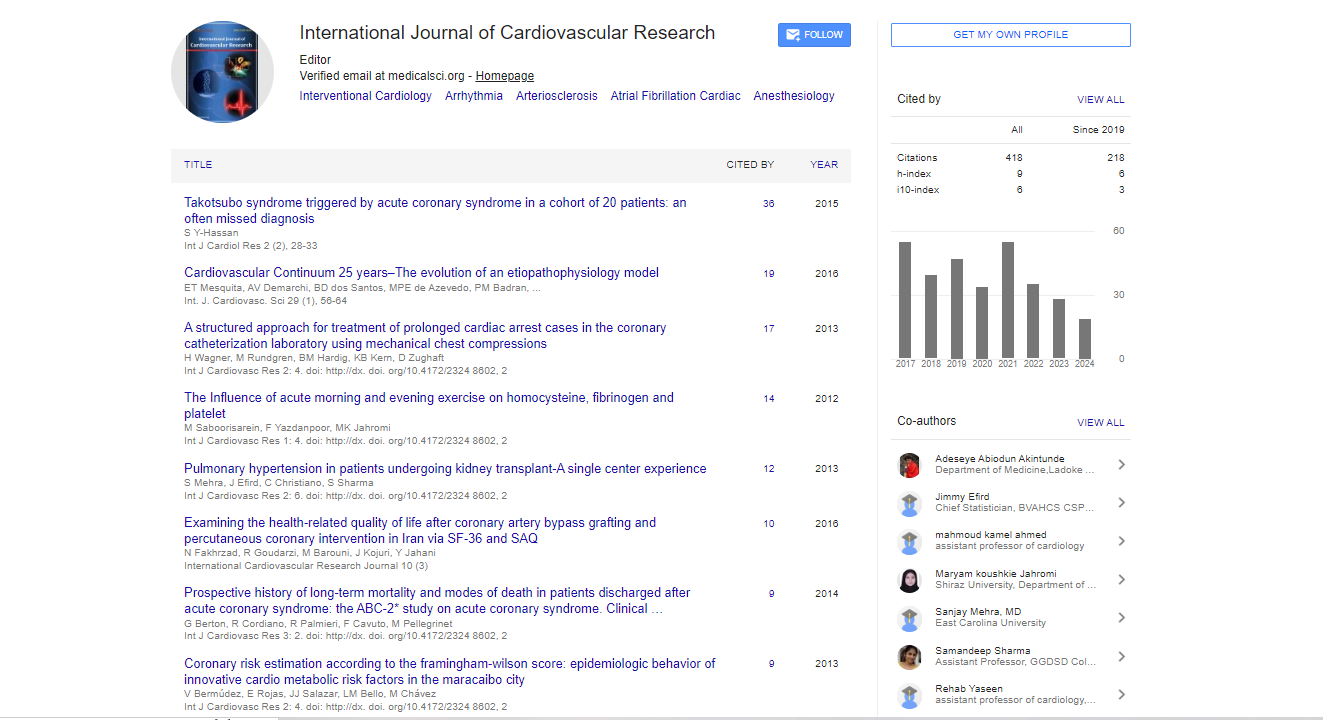Analysis of myocardial bridge in males and females of North Indian population- an angiographic study
Rajani singh
AIIMS, India
: Int J Cardiovas Res
Abstract
Myocardial bridging (MB) is congenital anatomic variation in which a band of cardiac muscle covers a part of an epicardial coronary artery. The artery under the cover of myocardium is known as ‘tunnelled segment’. The clinical implication of myocardial bridging is a debatable subject since early 1960s at the introduction of coronary arteriography. Myocardial bridge is considered benign by many authors but recent literature describes it as associated with various clinical conditions such as myocardial ischaemia, circulatory problems, angina, myocardial infarction, sudden cardiac death, systolic compression and other cardiac insults that may require surgical intervention. It is also said that myocardial bridges has ‘protective effect’ from atherosclerosis within the coronary artery that is bridged when compared with uncovered vessels of the same heart. The present study is aimed to analyse the presence of myocardial bridges over coronary arteries and their branches by coronary angiography. 380 coronary angiographs consisting of 292 male and 88 females were analysed retrospectively for the presence of MB on the coronary arteries and their branches in department of Anatomy and cardiology, AIIMS Rishikesh. 20 MBs was observed in 19 cases (2 females and 17males) out of 380 cases of angiographs (88 females and 292 males) constituting 5.26 %. Single MB was observed in 18 cases and two MBs were observed in one case. In 18 cases, MB was observed only on LAD while in one case; both LAD and LCX were covered by MB. Length of MB ranged between 12mm to 30 mm with mean 21.5 ± 2.12. Percentage reduction of diameter and area of coronary artery covered by MB ranged between 22.9- 78.69 and 40.48- 95.5 respectively. In our case all the patients with MB were having coronary artery diseases except one. Thus isolated MB may be benign anomaly but it is definitely a contributing factor in causing various coronary heart diseases. It is great challenge to cardiologist to detect symptomatic patients with MB and to plan better therapeutic and surgical interventions. An optimal use of new non-invasive diagnostic methods in combination with invasive methods will enhance our understanding of this anomaly and help in reducing the mortality.
Biography
Rajani Singh has completed MBBS and MS (Anatomy) from MLN Medical College University of Allahabad, India. She has the experience of 14 years teaching to medical graduates and post graduates in prime medical institute of India, currently she is additional professor of Anatomy in AIIMS Rishikesh Dehradun. She has published 65 quality publications in reputed national and international journals. She represented KGMU and AIIMS at 9 International and 15 national conferences of Anatomy but also awarded memberships of 4 internationally popular and 3 national anatomical societies. Besides being editor of Archives of Anatomy and Physiology India, Scientific pages Anatomy and Physiology, USA and Anatomy and Physiology open access, she is working as a member of editorial board of Clinical Anatomy, USA and member of Advisory board of OA Case Report London. She has written one chapter on Microanatomy of nerves to illiacus on invitation for ‘E-book of Human Anatomy at glance’ to be published by Austin Publication USA. She received best researchers and best paper awards.
E-mail: nani_sahayal@rediffmail.com
 Spanish
Spanish  Chinese
Chinese  Russian
Russian  German
German  French
French  Japanese
Japanese  Portuguese
Portuguese  Hindi
Hindi 



